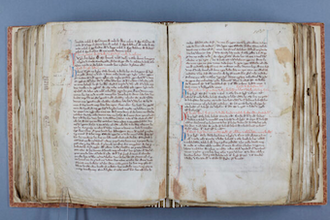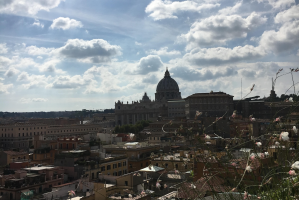Coronation Exhibition at Lambeth Palace Library

First surviving copy of Henry I's Coronation Charter
Marking the Coronation of King Charles III, a fascinating little exhibition at Lambeth Palace's new state of the art library highlights a selection of previous coronations from medieval times to the present. Words from Queen Elizabeth II's coronation speech provides the inspiration : "A declaration of our hopes for the future," Coronations from the Middle Ages to the present day"
Beginning with the first surviving copy of Henry I's Coronation Charter, which is cited as a precedent for Magna Carta by Archbishop Stephen Langton in 1215. Henry, grandson of William the Conqueror and crowned in 1100 swore to maintain the freedom and privileges of the church and to rectify injustices that his brother, the infamous William Rufus, had incurred. It can be seen as a prototype for Magna Carta .
Changes to the processional route, amendments and updating to the order of service are nothing new as is evidenced by the range of artefacts displayed.
One of the highlights is the print of the Enthronisation of King James 11 and his Queen Mary of Modena in 1687. James, the last Roman Catholic monarch of this country, instructed the Archbishop of York to make several amendments to the Coronation service, including the deletion of the Communion service. James ordered that "All that Art, Ornament and Expense could do to the making of the Spectacle Dazzling and Stupendous." A year later he was deposed in a bloodless revolution and his daughter Mary and her consort William of Orange were jointly crowned. A manuscript depicts their coronation service with amendments to the Coronation oath.
Part of a pamphlet indicates alternative suggestions for George III's processional route to offer the public more opportunity of visibility. However, in the event a short route was followed through new Palace Yard, along Parliament Street, Bridge Street and King Street to the Abbey's west door.
At George IV's Coronation the oath was misplaced, and he had to sign the Archbishop's copy and an ink blot is visible beside his signature.
A facsimile depicts a kneeling Queen Victoria beside the Coronation chair to receive the Sacrament with Lord Melbourne holding the Sword of state behind her.
A side room displays the cope and mitre worn by Archbishop Fisher in 1953 alongside the large prompt banners from the 1902 coronation of Edward VII from which Archbishop Frederick Temple had to read the service because of his failing eyesight. King Edward showed great concern for the Archbishops' health and frequently muttered that he was most anxious for him throughout the ceremony. He also insisted that the Archbishop of York should crown Queen Alexandra so as not to overtax the frail Archbishop Temple.
Archbishop Lang wrote of concerns about Edward VIII's attitude during preparations for the coronation that never took place due to his abdication. Following the coronation of his brother, King George VI, on 13th May 1937, the monarch wrote a touching letter expressing thanks for Archbishop Lang's support and kindness both in preparation for and during the Coronation.
Vestments worn by Archbishop Fisher at the last Coronation are displayed. After King Charles III's coronation the beautiful amethyst jewelled Morse clasp from the Archbishops' cope will be replaced and displayed with vestments worn at his coronation on 6th May. The Morse was made for Queen Victoria's coronation in 1838 and used at every one since. It was also worn at the funeral of the late Queen. The Bible which the King will swear the coronation oath on will join the exhibition. Four specially bound copies will also come to Lambeth
The final display case is dedicated to Her Late Majesty's coronation. The Queen wanted Prince Philip to have a role in the ceremony and it was agreed with the Archbishop that he should be first to pay her homage instead of the Archbishop. The Prelate prayed over both of them, blessing them as they knelt together.
The prayer book prepared for Queen Elizabeth before her Coronation is particularly poignant. The Community of St Andrew undertook this at the Archbishops' request. The order of deaconesses was founded in 1861 in North London. Mother Claire, their Mother Superior from 1942-64, was noted for her theological expositions.
The Queen's book of devotions was to be used between 1st.May and Coronation day on 2nd June. Reflections and prayers focused on different aspects of the forthcoming ceremony. Queen Elizabeth wrote to the Archbishop that she was reading it daily and finding it helpful to reflect on the different elements of the ceremony, pointing to her lifelong devout duty and Christian service.
The embossed red leather-bound Bible, designed by artist Lynton Lamb, that Queen Elizabeth proclaimed her oath upon is vividly displayed. The Bible was presented to her by the Moderator of the Church of Scotland, the first time that a leader of another church took part in a coronation. The Bible is inscribed: 'Here is Wisdom. This is the royal law. These are the lovely Oracles of God.'
At the forthcoming Coronation several faith leaders will be taking part as King Charles makes his own mark on the ancient and sacred ceremony.
A radical new inclusion will be universal Homage of the People where all in the Abbey and watching via the media will be called on to declare allegiance. "GOD SAVE THE KING"
Admission free
Until 13 July 9.30am-5pm Monday-Friday
Saturdays 13 May, 13 June and 8 July
For further details see: www.lambethpalacelibrary.info/


















